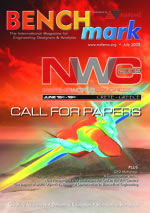BENCHmark July 2008
Who will provide the simulation engineers of tomorrow?

In this issue:
NAFEMS aims to keep its ear close to the ground, and to listen out for messages that are becoming widespread. In recent years, at many events where CAE professionals are gathered together, a particular message has been starting to resonate more and more loudly: from many different sources, we are frequently being told “we’re struggling to recruit good engineers to do our simulation”.
To make matters worse, many of the high value engineers who have spent most of their career are now approaching retirement.
At the same time, there seems to be unanimous agreement amongst industry pundits that the market for CAE continues to enjoy double digit growth. To be sustainable, this growth needs to be matched be an increase in the pool of engineers that can perform simulation. New generations of software designed to be used by engineers that are not full-time analysts goes some way towards alleviating this. But vendors have recognised that the shortage of suitably qualified and experienced staff is a key factor that threatens to limit the future growth of the market for simulation.
Unless universities and other educational establishments can start to feed through a significantly increased supply of new engineers (and unfortunately the reverse appears to be the case in some regions) the problem is only going to get worse in the future. With annual outputs of 25,000 engineers in the UK and 60,000 in the US being dwarfed by the 450,000 graduating from Indian engineering colleges, it is little wonder that so many large engineering companies are turning to India.
In fact, the offshoring of engineering services presents a $40 billion opportunity for the Indian economy by 2020, according to a study released by National Association of Software and Service Companies (NASSCOM). This trend is no longer being driven solely by the desire to drive down costs, but rather the availability of suitable manpower resources.
Even assuming that, by embracing a global approach such as this, sufficient engineering graduates can be tempted to take up a rewarding career in simulation (as opposed to the more lucrative but arguably less rewarding careers in finance, IT etc which have an equal thirst for capable and numerate graduates) they then need to gain appropriate and effective training and experience.
NAFEMS believes that, to be a highly competent engineering simulation professional, an engineering graduate should obtain:
Training in background theory to underpin the engineering application of numerical analysis
Familiarity with, and appreciation of, the limitations of the particular software employed
Numerical analysis experience - that is relevant experience in the specification, planning, execution and interpretation of numerical analysis applied to design, simulation or product verification
Understanding of the engineering aspects relevant to the particular products that are being worked upon
As we work our way down this list, the emphasis generally shifts from formal or semi-formal training to “on-the-job” training and experience. For an individual, obtaining this experience in any form of structured and efficient way proves to be very difficult. From the perspective of an employer, judging the quality of the experience gained is easier said than done.
There are no easy answers, but it should be recognised that NAFEMS is working hard to understand the different issues and formulate ideas for how it can offer some assistance.
Tim Morris, Chief Executive
July 2008



